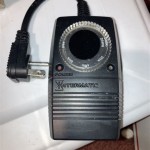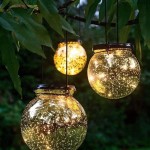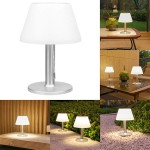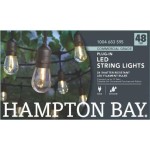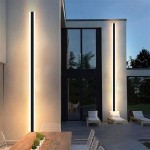Outdoor Light Fixtures That Won't Rust: A Comprehensive Guide
Outdoor lighting enhances the aesthetic appeal of residential and commercial properties while providing increased safety and security after dark. However, the weather can be harsh on outdoor fixtures. Rain, snow, humidity, and even salt spray can accelerate corrosion, leading to unsightly rust and eventual failure. Choosing the right materials and finishes is crucial for ensuring longevity and maintaining the appearance of outdoor light fixtures. Understanding the factors that contribute to rusting and knowing which materials offer superior resistance allows property owners to make informed decisions and invest in fixtures that will withstand the elements for years to come.
Understanding the Causes of Rust and Corrosion
Rust is a specific type of corrosion that affects iron and its alloys, such as steel. It's the result of an electrochemical reaction between iron, oxygen, and water. The presence of electrolytes, such as salt, acids, or pollutants, accelerates this process. This creates iron oxide, the reddish-brown substance commonly known as rust. Corrosion, on the other hand, is a broader term referring to the degradation of a material due to chemical reactions with its environment. While rust specifically affects iron-based metals, other metals can corrode in different ways, leading to discoloration, pitting, and weakening of the material. For example, copper can develop verdigris, a greenish coating, while aluminum can form a white, powdery oxide layer.
Several factors contribute to the speed and severity of rust and corrosion on outdoor light fixtures. Proximity to saltwater environments, such as coastal areas, significantly increases the risk due to the high concentration of salt in the air and rain. Industrial areas with high levels of air pollution also exacerbate corrosion. Acid rain, caused by pollutants like sulfur dioxide and nitrogen oxides, can dissolve protective coatings and accelerate the rusting process. Even regular exposure to rain and humidity can eventually lead to corrosion, especially if the fixtures are not properly protected.
Another critical factor is the presence of dissimilar metals in close proximity. This can create a galvanic cell, where one metal corrodes preferentially to protect the other. For example, if steel screws are used to attach aluminum components, the steel will likely corrode faster. Proper insulation and the use of compatible metals are essential to prevent galvanic corrosion.
Materials Resistant to Rust and Corrosion
Selecting the right materials is the most important step in preventing rust and corrosion in outdoor light fixtures. Several materials offer excellent resistance to these destructive processes, providing long-lasting performance in various environments.
Aluminum is a popular choice for outdoor fixtures due to its inherent corrosion resistance. When exposed to air, aluminum forms a thin, protective layer of aluminum oxide that prevents further oxidation. This layer is self-healing, meaning that if it's scratched or damaged, it will quickly reform, maintaining the metal's protection. Aluminum is also lightweight, making it easy to install and handle. However, not all aluminum alloys are created equal. Marine-grade aluminum alloys, such as 5052 and 6061, offer superior corrosion resistance in saltwater environments compared to standard alloys. Powder coating aluminum fixtures provides an additional layer of protection and allows for a wide range of color options.
Stainless Steel is another excellent material for outdoor lighting, particularly in demanding environments. It contains chromium, which forms a passive layer of chromium oxide on the surface, preventing rust and corrosion. The specific grade of stainless steel is important. 304 stainless steel is a common choice for general outdoor use, offering good corrosion resistance. However, 316 stainless steel, which contains molybdenum, provides superior protection against chloride corrosion, making it ideal for coastal areas and environments with high salt exposure. While stainless steel is more expensive than aluminum, its durability and longevity often justify the investment.
Copper is a naturally corrosion-resistant metal that develops a characteristic patina over time. This greenish coating, called verdigris, is a protective layer that prevents further corrosion. Copper fixtures offer a classic and elegant aesthetic and are often used in traditional architectural styles. While copper is resistant to rust, it can still corrode in certain environments, particularly those with high levels of sulfur dioxide. Regular cleaning can help maintain the appearance of copper fixtures and prevent excessive verdigris buildup. Using copper in combination with other corrosion-resistant materials for internal components can further extend the lifespan of the fixture.
Composite Materials are increasingly used in outdoor lighting due to their exceptional durability and resistance to rust and corrosion. These composite materials are typically made from fiberglass or polymers reinforced with other materials. They are lightweight, strong, and can be molded into a variety of shapes and designs. Composite fixtures are also resistant to UV damage, fading, and impact. They are an excellent alternative to metal fixtures, particularly in harsh environments where metal corrosion is a concern.
Brass is an alloy of copper and zinc, known for its aesthetic appeal and decent corrosion resistance. While brass is not completely immune to corrosion, it is more resistant than iron or steel. It develops a patina similar to copper, which can add to its visual charm. Regular polishing can maintain brass's original luster. However, in highly corrosive environments, brass fixtures may require additional protective coatings to prevent pitting and discoloration. Like copper, brass is better suited for locations with moderate environmental exposure and is often used in decorative lighting applications.
Protective Coatings and Finishes
Even when using corrosion-resistant materials, applying protective coatings and finishes can significantly extend the lifespan of outdoor light fixtures. These coatings create a barrier between the metal and the environment, preventing moisture, salt, and pollutants from reaching the surface. Several types of coatings are commonly used in outdoor lighting.
Powder Coating is a dry finishing process where finely ground particles of pigment and resin are electrostatically applied to a metal surface. The coated part is then baked in an oven, causing the powder to melt and fuse into a smooth, durable finish. Powder coating provides excellent protection against corrosion, UV damage, and abrasion. It's available in a wide range of colors and textures, allowing for customization of the fixture's appearance. Powder coating is particularly effective on aluminum and steel fixtures, providing a long-lasting and attractive finish.
Liquid Painting with specialized outdoor paints is another common method of protecting metal surfaces. It involves applying a liquid paint using spray guns or brushes. The paint forms a protective layer that resists moisture, UV radiation, and chemical exposure. The quality of the paint is crucial for achieving long-lasting protection. Look for paints specifically designed for outdoor use, containing UV inhibitors and corrosion-resistant pigments. Proper surface preparation is also essential for ensuring good adhesion and preventing paint peeling.
Anodizing is an electrochemical process that converts the surface of a metal, typically aluminum, into a durable, corrosion-resistant anodic oxide finish. This layer is integrated into the metal substrate, making it extremely durable and resistant to chipping or peeling. Anodizing also provides excellent abrasion resistance and can be colored in a variety of hues. It is a popular choice for aluminum fixtures, providing a long-lasting and aesthetically pleasing finish.
Galvanizing is a process of coating steel or iron with a layer of zinc to protect it from rusting. The zinc coating acts as a barrier, preventing moisture and oxygen from reaching the underlying metal. Even if the zinc coating is scratched, it will still provide protection through sacrificial corrosion, where the zinc corrodes preferentially to protect the steel. Hot-dip galvanizing is a common method, where the steel is immersed in molten zinc, creating a thick and durable coating. Galvanizing is often used for structural components and mounting hardware in outdoor lighting fixtures.
Clear Coatings are transparent coatings applied over bare metal surfaces to protect them from tarnishing and corrosion while maintaining their natural appearance. These coatings are typically acrylic or polyurethane-based and contain UV inhibitors to prevent fading. Clear coatings are often used on copper, brass, and stainless steel fixtures to preserve their original luster. Regular reapplication of the clear coat may be necessary to maintain its protective properties.
Maintenance and Care
Even with corrosion-resistant materials and protective coatings, regular maintenance and care are essential for extending the life of outdoor light fixtures. Simple maintenance practices can prevent the buildup of dirt, salt, and pollutants that can accelerate corrosion.
Regular Cleaning is the most basic maintenance task. Periodically washing the fixtures with mild soap and water removes dirt, dust, and salt buildup. Use a soft cloth or brush to avoid scratching the surface. Rinse thoroughly with clean water and allow the fixtures to dry completely. In coastal areas, more frequent cleaning may be necessary to remove salt spray.
Inspection of the fixtures should be performed regularly to identify any signs of corrosion or damage. Pay attention to areas where water can accumulate, such as joints, seams, and around mounting hardware. Look for signs of rust, discoloration, pitting, or paint peeling. Addressing these issues promptly can prevent them from escalating.
Lubrication of moving parts, such as hinges and latches, can prevent them from seizing due to corrosion. Use a silicone-based lubricant to protect these parts from moisture and prevent rust. Avoid using petroleum-based lubricants, as they can attract dirt and accelerate corrosion.
Touch-Up Painting should be performed on any areas where the paint or coating has been damaged. Clean the damaged area thoroughly and apply a rust-inhibiting primer before applying the touch-up paint. Match the color and type of paint to the original finish for a seamless repair.
Proper Drainage is essential for preventing water from accumulating in the fixture. Ensure that the fixture is installed with proper drainage to allow water to escape. Clear any debris that may be blocking drainage holes. Consider adding weep holes to the fixture to allow water to drain more effectively.
By understanding the causes of rust and corrosion, selecting the right materials and finishes, and implementing a regular maintenance program, property owners can ensure that their outdoor light fixtures remain beautiful and functional for years to come. These practices represent a proactive approach to outdoor lighting management, saving time and money on costly repairs and replacements in the long run.

Our New Nautical Rust Proof Outdoor Light Fixtures Table And Hearth

Our New Nautical Rust Proof Outdoor Light Fixtures Table And Hearth

Our New Nautical Rust Proof Outdoor Light Fixtures Table And Hearth

Our New Nautical Rust Proof Outdoor Light Fixtures Table And Hearth

Onion Outdoor Wall Lights Anti Rust Exterior Light Fixture With Bubble Glass Weather Proof Farmhouse Porch For Front Door Patio Yards Garage Rusted Broe Finish Com

Dewenwils Outdoor Wall Light Fixtures Outside Sconce Black Roman 17 7 H Exterior Lantern Anti Rust Waterproof Water Ripple Glass Mount Porch For House Garage A19 Bulbs Com

Craftsman 2 1 Light Matte Black Wall

2 Pack Outdoor Wall Lights Dusk To Dawn Sensor Sconce Exterior Shanulka Home Decor

Brightever Gooseneck Outdoor Wall Lanterns Pack Of 2 Exterior Light Fixtures Anti Rust Outside Barn Mount Sconces Waterproof White Patio Lamps For House Garage Front Door Bulb Excluded Yahoo Ping

Rustic Outdoor Lighting For Period Homes Jim Lawrence Blog

